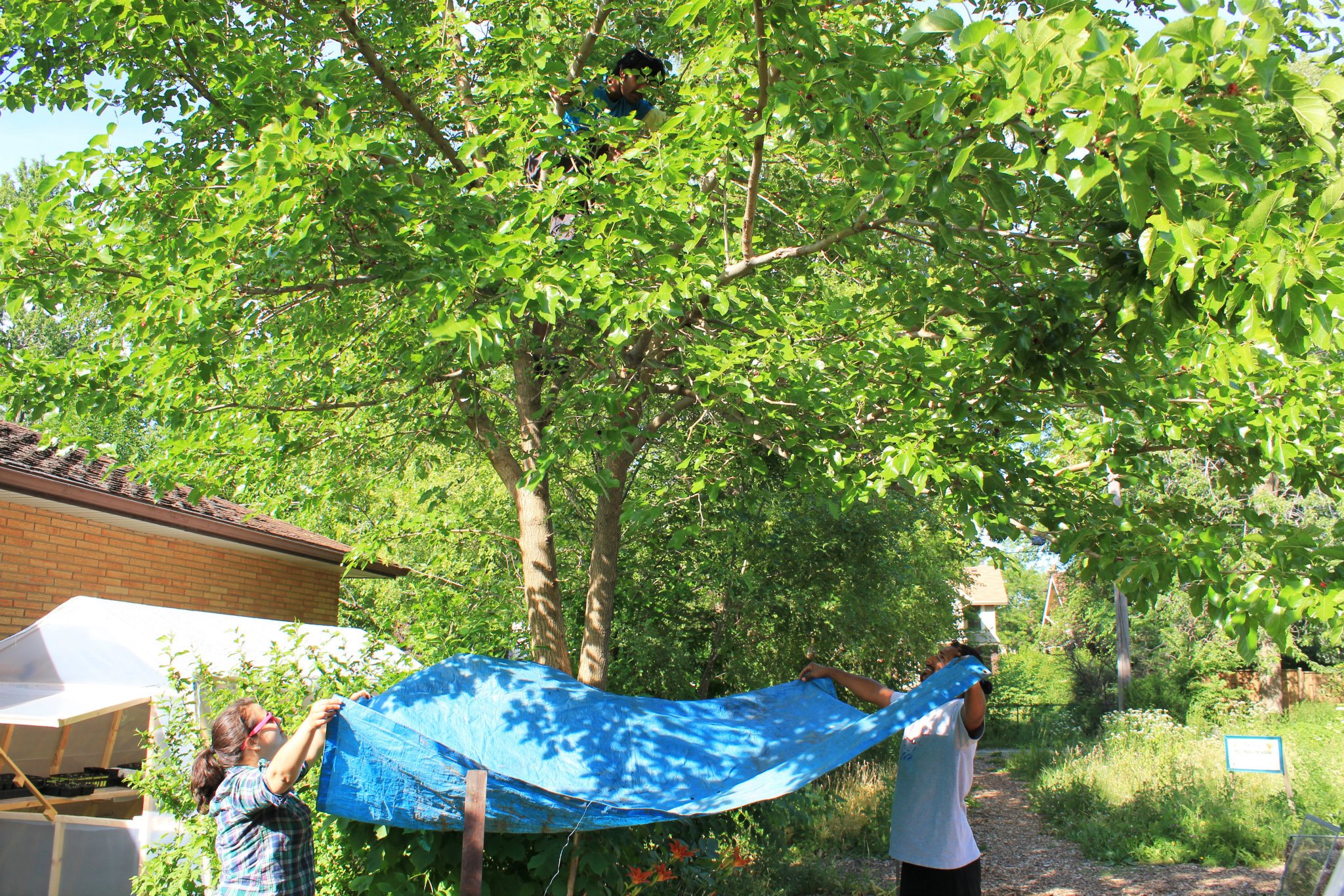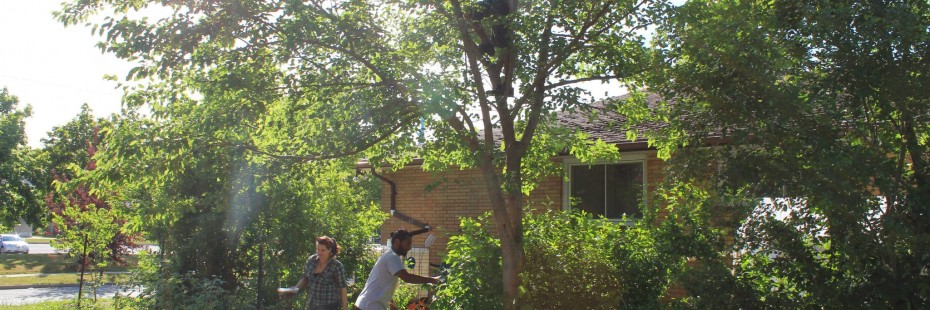Ode to the Mulberry Tree
Birds, squirrels, gardeners, and passerby’s all enjoyed the fruits or our mulberry tree this year. Jennifer extended the enjoyment through her mulberry sauces, jams and tarts. For some history on the Mulberry tree I’ve referenced a turn of the century (1900) book from England, Fruit and Its Cultivation, TW Sanders, for the following: “The Mulberry (Morus Nigra) is a native of Persia and belongs to the same order as the fig. It is reputed to have derived its generic name from the Latin word ‘Mora’, which means delay. The fitness of this name arises from the fact that it does not put forth its leaves until frosts are over. For this reason it has been called the ‘wisest of trees’“.
“Frequent mention is made of the mulberry in Holy writ, also by the early Greek writers Theophrastus and Dioscorides, and the Roman savants Virgil, Horace and Pliny. We owe its introduction into Europe to the Greeks. The Romans too esteemed the mulberry more than any other fruit. It is said the mulberry tree was first introduced into England in 1458. King James 1 encouraged the extensive planting of the mulberry, not however so much for the fruit as for feeding silk worms. Shakespeare alludes to the mulberry in several of his plays and was very partial to the tree.Wherever mulberry trees exist, the fruit is highly esteemed for its delicious, refreshing juice, whether for dessert, for tarts, or in many cases when made into wine.” (Any budding winemakers out there ?)
“The best way to gather the fruit is to spread cloths on the ground under the branches and then give the tree a gentle shake. By so doing, only those fruits that are fully ripe will fall off, and these will be in the best condition for eating”. (Kudos to Steve and Gary for having figured this efficient technique out last year, through their own ingenuity!)


Creating a Mulberry Guild
In nature plants tend to form themselves into cooperative communities (ecosystems). Permaculture is a gardening approach which examines how these natural systems organize themselves and attempts to utilize this knowledge in garden design. A guild is an example of his kind of approach. It can be defined as “a group of plants and animals harmoniously interwoven into a pattern of mutual support, often centered around one major species, that benefits humans while creating habitat.” Gaia’s Garden- A Guide to Home-Scale Permaculture, Toby Hemmingway, 2000.
To create a guild you might start with the major species and determine what plants evolved with it in its native locale. With the goal of creating a dynamic polyculture, you would then choose a combination of plants based on a mixture of beneficial qualities. Some plants are nitrogen fixators, others are nutrient accumulators and mulch makers, others are beneficial insect attractors or stimulate development of micro organisms in the soil.
Given the Mediterranean origins of the mulberry tree, you might start by positioning some rocks and beach gravel mulch, at the drip line of the tree on the south, east and west sides of the circle. These areas would be planted with Mediterranean herbs such as Thyme and oregano. More sun gets at these areas, and the rocks absorb and release heat which these herbs like. These plants attract beneficial insects, such as predator wasps. On the north side, which would be more deeply shaded, a few pieces of decorative logs or root burls could finish the perimeter. The wood creates further habitat for insects that can enhance soil life such as worms, millipedes etc. This also creates an area where leaf litter will accumulate and leaf mulch can be added. This “woodland habitat” would be a good area for sweet woodruff, and woodland wildflowers such as Jack in the Pulpit, trilliums, trout lilies etc.
Just inside the herbal perimeter some yarrow could be established. Yarrow flowers provide food and habitat for a variety of beneficial insects such as lady beetles and parasitic wasps. Yarrow, along with Comfrey are nutrient accumulators and are also plants used in biodynamic gardening approaches, to increase biological activity in the soil. Yarrow is a plant that is often found growing around the walls of castles. It has antiseptic properties and was used by soldiers as a poultice for treating wounds.
Comfrey would be another plant to include in the mix. Comfrey’s deep roots mine micronutrients and potassium. In addition to being a nutrient accumulator it is also a mulch maker. The plentiful , thick leaves can be cut back throughout the season and left on the soil for mulch. These decompose releasing nutrients for the plant community. Comfrey also has healing properties when used externally. The leaves are gelatinous and the juice from them , which contains allatoins, can be used as a moisturizer and to treat minor cuts and scrapes in the garden. Their flowers also feed beneficial insects.
Crown Vetch could also be planted in this community as a nitrogen fixator, ground cover, and beneficial insect attractor. It too can be cut back and the leaves left on the ground to contribute to the mulch mix. “Weeds” such as dandelion, plantain, and chicory act as nutrient accumulators. If they spring up they can be left in the mix. Bulbs such as daffodils, chives and scillia provide visual appeal, while helping to out compete grass. These bulbs may also have some capacity to deter bark chewing animals. Lupines are another nitrogen fixating plant that could be added. Their seeds are also attractive to birds.
In this system there were no annuals used other than the crown vetch which reseeds itself. Once the plant community is established, it becomes a permanent self sustaining ecosystem, that will develop and evolve more or less on its own. It will create a living mulch, that will shade the soil and reduce evaporation, while shading out unwanted weeds and grasses. The cut and come again mulch will create a thick layer of compost in place, doing away with the need to make and haul compost to the site. This creates a thriving , undisturbed environment for a diverse population of worms, beetles, millipedes, fungi, bacteria, and other helpful micro-organisms. The increased life and diversity in the soil and on top of the soil, suppresses diseases and pest problems. The churning, balanced ecosystem doesn’t allow for one species to become a pest, whether that is harmful insects or fungal diseases.
Now that the basic structure of our Campus Community Garden is established, I’m hopeful that we can begin to apply these permaculture principles in a more intense and methodical way, establishing similar guilds throughout the garden. This would mean reducing our reliance on woodchip mulching and increasing the use of living mulches and cover crops. We need to reduce the use of annuals and increase the planting of more trees, shrubs and beneficial perennials, organized as plant communities.
Perhaps we could use the “wisest of trees” as a starting point and demonstration site for these principles. – Chris Reid

